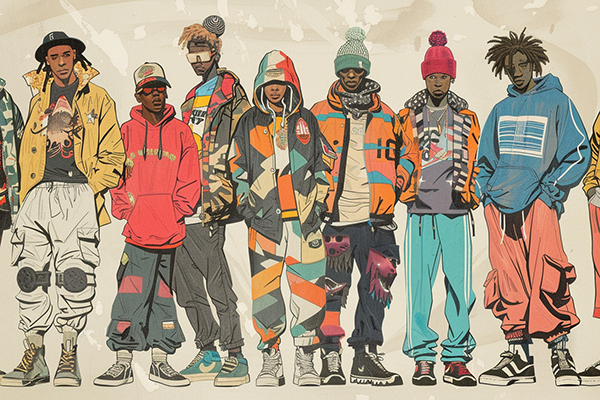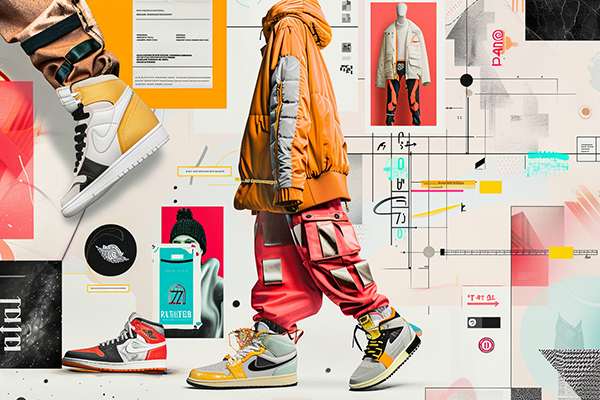Streetwear has evolved from a subculture movement into a global fashion phenomenon. Rooted in urban culture and characterized by bold graphics, oversized fits, and casual aesthetics, streetwear bridges the gap between individual expression and mainstream trends. But who buys streetwear, and what drives its popularity?
The target market for streetwear clothing includes young, trend-conscious individuals, typically Gen Z and Millennials, who are influenced by urban culture, music, and social media.
In this article, we’ll explore the cultural roots of streetwear, the types of streetwear styles, its market outlook, and the demographics that drive this influential fashion category.
What culture is streetwear?
Streetwear culture is deeply connected to urban lifestyles, blending influences from skateboarding, hip-hop, and youth rebellion.
Streetwear originates from urban culture, primarily skateboarding and hip-hop communities, and is driven by self-expression, individuality, and subcultural identities.

1. Roots in Skateboarding
- The Skate Scene:
- In the 1980s, brands like Stüssy and Supreme1 emerged, creating casual, functional clothing for skaters.
- Skateboarding’s DIY ethos inspired streetwear’s emphasis on individuality and rebellion.
2. Influence of Hip-Hop
- Music and Fashion:
- Hip-hop culture brought oversized silhouettes, bold colors, and logo-heavy designs into the mix.
- Iconic figures like Run-D.M.C. (with Adidas)2 and Kanye West (Yeezy) shaped streetwear’s integration into pop culture.
3. Global Subcultures
- Regional Variations:
- Japan: Harajuku streetwear3 emphasizes bold layering and avant-garde aesthetics.
- Europe: Brands like Off-White merge luxury with streetwear, creating high-fashion hybrids.
4. Modern Social Media Influence
- Instagram and TikTok:
- Streetwear thrives on platforms where influencers and celebrities showcase limited-edition drops, fostering a sense of exclusivity.
| Cultural Influence | Impact on Streetwear |
|---|---|
| Skateboarding | Casual, functional clothing, DIY culture |
| Hip-Hop | Bold colors, oversized fits, logo designs |
| Global Subcultures | Regional variations, high-fashion hybrids |
| Social Media | Visibility, exclusivity, and trends |
Streetwear’s cultural roots make it a reflection of urban youth and their desire for self-expression.
What are the four types of streetwear?
Streetwear is not a one-size-fits-all category; it spans multiple styles and subgenres, each catering to a different audience.
The four main types of streetwear are skatewear, luxury streetwear, sportswear-inspired, and techwear, each offering unique aesthetics and purposes.

1. Skatewear
-
Characteristics:
- Casual, functional clothing designed for skateboarding.
- Includes graphic tees, hoodies, and sneakers.
-
Key Brands:
- Supreme, Vans, Thrasher.
-
Audience:
- Skaters and fans of skate culture.
2. Luxury Streetwear
-
Characteristics:
- Combines streetwear elements with high-end materials and craftsmanship.
- Features bold logos, designer collaborations, and limited-edition items.
-
Key Brands:
- Off-White, Balenciaga, Fear of God.
-
Audience:
- Affluent consumers and fashion-forward individuals.
3. Sportswear-Inspired
-
Characteristics:
- Rooted in athletic aesthetics, with tracksuits, sneakers, and oversized jerseys.
- Focuses on comfort and performance.
-
Key Brands:
- Adidas Originals, Nike, Puma.
-
Audience:
- Fitness enthusiasts and casual streetwear fans.
4. Techwear
-
Characteristics:
- Futuristic designs with functional features like waterproof fabrics and hidden pockets.
- Emphasizes utility and minimalism.
-
Key Brands:
- ACRONYM, Stone Island, Nike ACG.
-
Audience:
- Outdoor enthusiasts, gamers, and futuristic fashion fans.
| Streetwear Type | Key Features | Target Audience |
|---|---|---|
| Skatewear | Casual, functional, graphic-heavy | Skaters, urban youth |
| Luxury Streetwear | High-end materials, bold logos | Affluent consumers, fashion enthusiasts |
| Sportswear-Inspired | Tracksuits, sneakers, oversized fits | Fitness fans, casual dressers |
| Techwear | Functional, futuristic, minimalist | Outdoor enthusiasts, tech-savvy consumers |
These subgenres showcase streetwear’s ability to cater to diverse audiences while retaining its urban edge.
What is the market outlook for streetwear?
Streetwear has transitioned from niche to mainstream, becoming a billion-dollar industry with no signs of slowing down.
The streetwear market is expected to grow at a compound annual growth rate (CAGR) of 5.4% from 2023 to 20304, driven by global demand, digital influence, and the rise of collaborations between streetwear and luxury brands.

Key Drivers of Growth
-
Globalization of Streetwear
- Emerging markets in Asia-Pacific and South America are experiencing a surge in demand for streetwear, driven by urbanization and youth culture.
-
Luxury Collaborations
- Partnerships between streetwear and high-end brands (e.g., Louis Vuitton x Supreme5) have elevated streetwear into the luxury space, attracting affluent consumers.
-
Digital Influence
- Social media platforms and e-commerce have made streetwear more accessible, allowing brands to reach global audiences instantly.
-
Drop Culture
- Limited-edition releases and “hype” products continue to drive demand and create exclusivity.
Challenges
-
Sustainability:
- The streetwear industry faces growing pressure to adopt eco-friendly practices, as younger consumers demand accountability.
-
Market Saturation:
- The abundance of new brands entering the market makes it harder for smaller players to stand out.
Future Opportunities
- Sustainability Initiatives:
- Brands that prioritize recycled materials and ethical practices will gain favor among environmentally-conscious consumers.
- Technological Integration:
- Augmented reality (AR) for virtual fittings and blockchain for product authentication could revolutionize how streetwear is sold.
| Market Driver | Impact |
|---|---|
| Globalization | Expands streetwear to emerging markets |
| Luxury Collaborations | Elevates streetwear into high-end fashion |
| Drop Culture | Sustains exclusivity and consumer interest |
| Sustainability Trends | Aligns with consumer values |
The streetwear market’s growth potential lies in its adaptability to consumer trends and its ability to blend exclusivity with mass appeal.
Who usually wears streetwear?
Streetwear’s audience is diverse, but it remains rooted in youth culture and urban communities.
Streetwear is most popular among Gen Z and Millennials, particularly those influenced by music, skateboarding, and social media culture.

Key Demographics
-
Age Groups
- Gen Z (18–24 years old):
- Streetwear resonates with their desire for self-expression and social media influence.
- Millennials (25–40 years old):
- This group appreciates streetwear’s nostalgic links to 1990s and early 2000s pop culture.
- Gen Z (18–24 years old):
-
Gender
- Streetwear is largely gender-neutral, appealing equally to men and women.
-
Income Levels
- Streetwear fans range from budget-conscious students to affluent collectors of high-end pieces.
-
Cultural Ties
- Strongly appeals to urban youth influenced by skateboarding, hip-hop, and online gaming.
Why They Wear Streetwear
- Self-Expression:
- Streetwear allows individuals to showcase their personality through bold graphics and unique fits.
- Community Belonging:
- Wearing certain brands or limited-edition items fosters a sense of identity and belonging.
- Status Symbol:
- Exclusive drops and luxury collaborations make certain pieces highly coveted.
| Demographic | Why They Wear Streetwear |
|---|---|
| Gen Z | Influenced by social media and trends |
| Millennials | Nostalgia and casual fashion preferences |
| Urban Youth | Reflects cultural identity |
| Affluent Consumers | Status and exclusivity |
Streetwear’s diverse audience reflects its universal appeal and ability to adapt across demographics and lifestyles.
Conclusion
The target market for streetwear clothing spans Gen Z, Millennials, and urban youth influenced by skateboarding, hip-hop, and digital culture. Rooted in self-expression and community, streetwear thrives on its ability to cater to diverse styles, from skatewear to luxury streetwear. With a promising market outlook driven by globalization, sustainability, and digital innovations, streetwear remains a dominant force in modern fashion. Its inclusive appeal ensures that everyone, from budget-conscious students to high-end collectors, can find a place within this vibrant culture.













